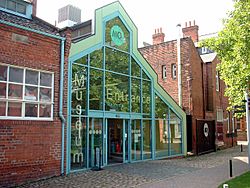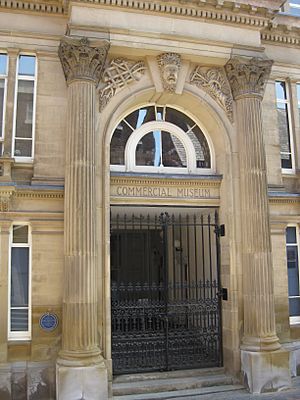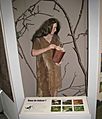Hull and East Riding Museum facts for kids
 |
|
| Established | 1989 |
|---|---|
| Location | Kingston upon Hull, England |
| Visitors | 76,792 (2014) |
| Public transit access | Hull Paragon Interchange (10 minute walk) |
The Hull and East Riding Museum of Archaeology is a cool place to visit in the Old Town of Kingston upon Hull, England. It's part of the city's special Museums Quarter. This museum first opened in 1925, but it was called the Museum of Commerce and Industry back then. In 1989, it got its current name after a big update. The museum shows amazing items from ancient times, like the Stone Age, all the way up to the Middle Ages. Many displays feature life-size scenes or rebuilt rooms and buildings from the past.
Contents
History of the Museum Building
The building where the museum is located, at 36 High Street, has a long history. It was first a customs house, which is where taxes were collected on goods coming into the city. In the 1850s, city leaders decided to build a new corn exchange there. A corn exchange was a place where farmers and traders bought and sold grain.
The building you see today was finished in 1856. It was designed in a style called Italianate, which looks like old Italian buildings. As time went on, people used the building less for trading corn. It became empty and started to fall apart.
In 1925, the building was fixed up and opened as a museum. It was called the Museum of Commerce and Industry. During the Second World War, the building was damaged by bombs. But it was repaired and reopened in 1957 as the Archaeology and Transport Museum.
In 1989, the museum changed its name again to the Hull and East Riding Museum of Archaeology. This happened because the transport collection moved to a new museum next door, called the Streetlife Museum of Transport. The museum had another big makeover between 1998 and 2003. This was part of creating the Museums Quarter, a special area with several museums. The main entrance was moved to a central courtyard, making it easier for visitors to find.
Like many places, the museum closed to the public on March 20, 2020, because of the COVID-19 pandemic. It was able to welcome visitors back on May 17, 2021.
Exploring the Galleries
The museum has several exciting galleries. A cool thing about them is that they show real objects found in the region. These items are often displayed in special scenes called tableaux. These scenes show what life was like in different time periods. Some even have full-size rooms or buildings that have been rebuilt.
Fossils and Early Animals
When you first enter, you'll see a giant woolly mammoth! There are also other extinct animals that once lived in the area. You can even touch some fossils at the interactive displays.
Prehistoric Man
This gallery shows what life was like for early humans. You might see a scene of a woman gathering food. You can learn about what people ate and the tools they used long ago. There are stone tools, pottery from the Bronze Age, metal items, and wooden carvings. Many of these were collected by a famous archaeologist named John Robert Mortimer. The mysterious Roos Carr figures are also on display here.
Celtic Worlds
Step back in time to the Iron Age in this gallery! You can see a reconstructed part of an Iron Age village. If you need help understanding the displays, translations are available at the reception desk.
Boat Lab
This section features the amazing Hasholme Logboat. This boat is about 12.78 meters (41.9 feet) long and 1.4 meters (4.6 feet) wide. It was carved from a single oak tree around 300 BC! You can also see a piece of one of the three Ferriby Boats. These boats are from about 2000 BC and are the oldest known sewn plank boats in Europe.
Roman World (AD 43–410)
Discover what life was like when the Romans were in Britain. This gallery includes a rebuilt part of the Roman settlement of Petuaria, which is now modern-day Brough, East Riding of Yorkshire. You'll see large, real mosaics displayed as they would have looked in Roman houses. There's even a Roman bath house with an original mosaic and a life-sized statue of a bather. You can also explore a workshop, office, and shop, where ancient Roman items are shown as if they were for sale. Look closely for some funny Latin graffiti that says Romani ite domum ("Romans go home") on a building wall!
The museum has an incredible collection of Roman mosaics. These were found at Roman villa sites in places like Rudston, Brantingham, Harpham, and Horkstow. They are considered some of the best late Roman mosaics you can see in Britain.
Upper Galleries
These galleries show life in East Yorkshire after the Romans left, starting from AD 410. You can learn about the Saxons, the Vikings, and life in Medieval Hull. Displays include old coins, weapons, stone carvings, and everyday objects that people used long ago.
Images for kids
See also
- Corn exchanges in England













